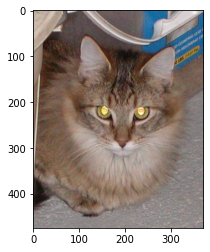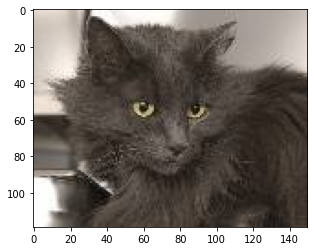import os import tensorflow.compat.v1 as tf tf.disable_v2_behavior() from PIL import Image import matplotlib.pyplot as plt import numpy as np import cv2
def get_files(file_dir): cats=[] #猫的图片 列表 lable_cats=[] #猫的标签 列表 dogs=[] #狗的图片 列表 lable_dogs=[] #狗的标签 列表 #os.listdir为列出路径内的所有文件 for file in os.listdir(file_dir): name = file.split('.') #将每一个文件名都进行分割,以.分割 #这样文件名 就变成了三部分 name的形式 [‘dog’,‘9981’,‘jpg’] if name[0]=='cat': cats.append(file_dir+file) #在定义的cats列表内添加图片路径,由文件夹的路径+文件名组成 lable_cats.append(0) #在猫的标签列表中添加对应图片的标签,猫的标签为0,狗为1 else: dogs.append(file_dir+file) lable_dogs.append(1) print('There are %d cats\nThere are %d dogs' %(len(cats), len(dogs))) #打印猫和狗的数量 image_list = np.hstack((cats, dogs)) #将猫和狗的列表合并为一个列表 label_list = np.hstack((lable_cats, lable_dogs)) #将猫和狗的标签列表合并为一个列表 #将两个列表构成一个数组 temp=np.array([image_list,label_list]) temp=temp.transpose() #将数组矩阵转置 np.random.shuffle(temp) #将数据打乱顺序,不再按照前边全是猫,后面全是狗这样排列 image_list=list(temp[:,0]) #图片列表为temp 数组的第一个元素 label_list = list(temp[:, 1]) #标签列表为temp数组的第二个元素 label_list = [int(i) for i in label_list] #转换为int类型 #返回读取结果,存放在image_list,和label_list中 return image_list, label_list
def get_batch(image,label,image_W,image_H,batch_size,capacity): #数据转换 image = tf.cast(image, tf.string) #将image数据转换为string类型 label = tf.cast(label, tf.int32) #将label数据转换为int类型 #入队列 input_queue = tf.train.slice_input_producer([image, label]) #取队列标签 张量 label = input_queue[1] #取队列图片 张量 image_contents = tf.read_file(input_queue[0]) #解码图像,解码为一个张量 image = tf.image.decode_jpeg(image_contents, channels=3) #对图像的大小进行调整,调整大小为image_W,image_H image = tf.image.resize_image_with_crop_or_pad(image, image_W, image_H) #对图像进行标准化 image = tf.image.per_image_standardization(image) #等待出队 image_batch, label_batch = tf.train.batch([image, label], batch_size= batch_size, num_threads= 64, capacity = capacity) label_batch = tf.reshape(label_batch, [batch_size]) #将label_batch转换格式为[] image_batch = tf.cast(image_batch, tf.float32) #将图像格式转换为float32类型 return image_batch, label_batch #返回所处理得到的图像batch和标签batch
import matplotlib.pyplot as plt BATCH_SIZE = 2 CAPACITY = 256 IMG_W = 208 IMG_H = 208 train_dir = './dataset/dc/train/' image_list, label_list = get_files(train_dir) #读取数据和标签 image_batch, label_batch = get_batch(image_list, label_list, IMG_W, IMG_H, BATCH_SIZE, CAPACITY) #将图片分批次 #开启会话,使用try--except--finally结构来执行队列操作 with tf.Session() as sess: i = 0 coord = tf.train.Coordinator() threads = tf.train.start_queue_runners(coord=coord) try: while not coord.should_stop() and i<2: img, label = sess.run([image_batch, label_batch]) # just test one batch for j in np.arange(BATCH_SIZE): print('label: %d' %label[j]) #j-index of quene of Batch_size plt.imshow(img[j,:,:,:]) plt.show() i+=1 except tf.errors.OutOfRangeError: print('done!') finally: coord.request_stop() coord.join(threads)
def inference(images, batch_size, n_classess): """ 第一个卷积层 """ # tf.variable_scope() 主要结合 tf.get_variable() 来使用,实现变量共享。下次调用不用重新产生,这样可以保存参数 with tf.variable_scope('conv1') as scope: #初始化权重,[3,3,3,16] weights = tf.get_variable('weights', shape = [3, 3, 3, 16], dtype = tf.float32, initializer = tf.truncated_normal_initializer(stddev=0.1, dtype=tf.float32)) #初始化偏置,16个 biases = tf.get_variable('biases', shape=[16], dtype = tf.float32, initializer = tf.constant_initializer(0.1)) conv = tf.nn.conv2d(images, weights, strides=[1,1,1,1], padding='SAME') # 将偏置加在所得的值上面 pre_activation = tf.nn.bias_add(conv, biases) # 将计算结果通过relu激活函数完成去线性化 conv1 = tf.nn.relu(pre_activation, name= scope.name) """ 池化层 """ with tf.variable_scope('pooling1_lrn') as scope: # tf.nn.max_pool实现了最大池化层的前向传播过程,参数和conv2d类似,ksize过滤器的尺寸 pool1 = tf.nn.max_pool(conv1, ksize=[1,3,3,1],strides=[1,2,2,1],padding='SAME',name='poolong1') # 局部响应归一化(Local Response Normalization),一般用于激活,池化后的一种提高准确度的方法。 norm1 = tf.nn.lrn(pool1, depth_radius=4, bias=1, alpha=0.001/9.0, beta=0.75, name='norm1') """ 第二个卷积层 """ # 计算过程和第一层一样,唯一区别为命名空间 with tf.variable_scope('conv2') as scope: weights = tf.get_variable('weights', shape=[3,3,16,16], dtype=tf.float32, initializer=tf.truncated_normal_initializer(stddev=0.1,dtype=tf.float32)) biases = tf.get_variable('biases', shape=[16], dtype=tf.float32, initializer=tf.constant_initializer(0.1)) conv = tf.nn.conv2d(norm1, weights, strides=[1,1,1,1],padding='SAME') pre_activation = tf.nn.bias_add(conv, biases) conv2 = tf.nn.relu(pre_activation, name='conv2') """ 第二池化层 """ with tf.variable_scope('pooling2_lrn') as scope: norm2 = tf.nn.lrn(conv2, depth_radius=4,bias=1,alpha=0.001/9,beta=0.75,name='norm2') pool2 = tf.nn.max_pool(norm2, ksize=[1,3,3,1],strides=[1,1,1,1],padding='SAME',name='pooling2') """ local3 全连接层 """ with tf.variable_scope('local3') as scope: # -1代表的含义是不用我们自己指定这一维的大小,函数会自动计算 reshape = tf.reshape(pool2, shape=[batch_size, -1]) # 获得reshape的列数,矩阵点乘要满足列数等于行数 dim = reshape.get_shape()[1].value weights = tf.get_variable('weights', shape=[dim,128],dtype=tf.float32,initializer=tf.truncated_normal_initializer(stddev=0.005,dtype=tf.float32)) biases = tf.get_variable('biases',shape=[128], dtype=tf.float32,initializer=tf.constant_initializer(0.1)) local3 = tf.nn.relu(tf.matmul(reshape, weights) + biases, name=scope.name) """ local4 全连接层 """ with tf.variable_scope('local4') as scope: weights = tf.get_variable('weights',shape=[128,128],dtype=tf.float32,initializer=tf.truncated_normal_initializer(stddev=0.005,dtype=tf.float32)) biases = tf.get_variable('biases', shape=[128],dtype=tf.float32, initializer=tf.constant_initializer(0.1)) local4 = tf.nn.relu(tf.matmul(local3,weights) + biases, name = 'local4') """ lsoftmax逻辑回归 将前面的全连接层输出,做一个线性回归,计算出每一类的得分,在这里是2类 所以这个层输出的是2个得分 """ with tf.variable_scope('softmax_linear') as scope: weights = tf.get_variable('softmax_linear',shape=[128, n_classess],dtype=tf.float32,initializer=tf.truncated_normal_initializer(stddev=0.005,dtype=tf.float32)) biases = tf.get_variable('biases',shape=[n_classess],dtype=tf.float32,initializer=tf.constant_initializer(0.1)) softmax_linear = tf.add(tf.matmul(local4, weights),biases,name='softmax_linear') return softmax_linear
def losses(logits, labels): with tf.variable_scope('loss') as scope: # 计算使用了softmax回归后的交叉熵损失函数 # logits表示神经网络的输出结果,labels表示标准答案 cross_entropy = tf.nn.sparse_softmax_cross_entropy_with_logits(logits=logits, labels=labels,name='xentropy_per_example') # 求cross_entropy所有元素的平均值 loss = tf.reduce_mean(cross_entropy, name='loss') # 对loss值进行标记汇总,一般在画loss, accuary时会用到这个函数。 tf.summary.scalar(scope.name+'/loss',loss) return loss
def trainning(loss, learning_rate): with tf.name_scope('optimizer'): # 在训练过程中,先实例化一个优化函数,比如tf.train.GradientDescentOptimizer,并基于一定的学习率进行梯度优化训练 optimizer = tf.train.AdamOptimizer(learning_rate=learning_rate) # 设置一个用于记录全局训练步骤的单值 global_step = tf.Variable(0, name='global_step',trainable=False) # 添加操作节点,用于最小化loss,并更新var_list,返回为一个优化更新后的var_list,如果global_step非None,该操作还会为global_step做自增操作 train_op = optimizer.minimize(loss, global_step=global_step) return train_op
def evaluation(logits, labels): with tf.variable_scope('accuracy') as scope: correct = tf.nn.in_top_k(logits,labels,1) # 计算预测的结果和实际结果的是否相等,返回一个bool类型的张量 # K表示每个样本的预测结果的前K个最大的数里面是否含有target中的值。一般都是取1。 # 转换类型 correct = tf.cast(correct, tf.float16) accuracy = tf.reduce_mean(correct) #取平均值,也就是准确率 # 对准确度进行标记汇总 tf.summary.scalar(scope.name+'/accuracy',accuracy) return accuracy
import os import numpy as np import tensorflow.compat.v1 as tf tf.disable_v2_behavior() from PIL import Image import matplotlib.pyplot as plt N_CLASSES = 2 # 二分类问题,只有是还是否,即0,1 IMG_W = 208 #图片的宽度 IMG_H = 208 #图片的高度 BATCH_SIZE = 16 #批次大小 CAPACITY = 2000 # 队列最大容量2000 MAX_STEP = 5000 #最大训练步骤 learning_rate = 0.0001 #学习率
def run_training(): """ ##1.数据的处理 """ # 训练图片路径 train_dir = './dataset/dc/train/' # 输出log的位置 logs_train_dir = './model/' # 模型输出 train_model_dir = './model/' # 获取数据中的训练图片 和 训练标签 train, train_label = get_files(train_dir) # 获取转换的TensorFlow 张量 train_batch, train_label_batch = get_batch(train,train_label,IMG_W,IMG_H,BATCH_SIZE,CAPACITY) """ ##2.网络的推理 """ # 进行前向训练,获得回归值 train_logits = inference(train_batch, BATCH_SIZE, N_CLASSES) """ ##3.定义交叉熵和 要使用的梯度下降的 优化器 """ # 计算获得损失值loss train_loss = losses(train_logits, train_label_batch) # 对损失值进行优化 train_op = trainning(train_loss, learning_rate) """ ##4.定义后面要使用的变量 """ # 根据计算得到的损失值,计算出分类准确率 train__acc = evaluation(train_logits, train_label_batch) # 将图形、训练过程合并在一起 summary_op = tf.summary.merge_all() # 新建会话 sess = tf.Session() # 将训练日志写入到logs_train_dir的文件夹内 train_writer = tf.summary.FileWriter(logs_train_dir, sess.graph) saver = tf.train.Saver() # 保存变量 # 执行训练过程,初始化变量 sess.run(tf.global_variables_initializer()) # 创建一个线程协调器,用来管理之后在Session中启动的所有线程 coord = tf.train.Coordinator() # 启动入队的线程,一般情况下,系统有多少个核,就会启动多少个入队线程(入队具体使用多少个线程在tf.train.batch中定义); threads = tf.train.start_queue_runners(sess=sess, coord=coord) """ 进行训练: 使用 coord.should_stop()来查询是否应该终止所有线程,当文件队列(queue)中的所有文件都已经读取出列的时候, 会抛出一个 OutofRangeError 的异常,这时候就应该停止Sesson中的所有线程了; """ try: for step in np.arange(MAX_STEP): #从0 到 2000 次 循环 if coord.should_stop(): break _, tra_loss, tra_acc = sess.run([train_op, train_loss, train__acc]) # 每50步打印一次损失值和准确率 if step % 50 == 0: print('Step %d, train loss = %.2f, train accuracy = %.2f%%' % (step, tra_loss, tra_acc * 100.0)) summary_str = sess.run(summary_op) train_writer.add_summary(summary_str, step) # 每2000步保存一次训练得到的模型 if step % 2000 == 0 or (step + 1) == MAX_STEP: checkpoint_path = os.path.join(train_model_dir, 'model.ckpt') saver.save(sess, checkpoint_path, global_step=step) # 如果读取到文件队列末尾会抛出此异常 except tf.errors.OutOfRangeError: print('Done training -- epoch limit reached') finally: coord.request_stop() # 使用coord.request_stop()来发出终止所有线程的命令 coord.join(threads) # coord.join(threads)把线程加入主线程,等待threads结束 sess.close() # 关闭会话
import tensorflow.compat.v1 as tf tf.disable_v2_behavior() import numpy as np import math from PIL import Image import matplotlib.pyplot as plt import tempfile # 获取一张图片 def get_one_image(data): n = len(data) #训练集长度 ind = np.random.randint(0, n) #生成随机数 img_dir = data[ind] #从训练集中提取选中的图片 image = Image.open(img_dir) plt.imshow(image) #显示图片 plt.show() image = image.resize([208, 208]) image = np.array(image) return image def get_one_image_file(img_dir): image = Image.open(img_dir) plt.imshow(image) #显示图片 plt.show() image = image.resize([208, 208]) image = np.array(image) return image
def evaluate_one_image(): # 数据集路径 image_array=get_one_image_file("./dataset/dc/test/38.jpg") with tf.Graph().as_default(): BATCH_SIZE = 1 # 获取一张图片 N_CLASSES = 2 #二分类 image = tf.cast(image_array, tf.float32) image = tf.image.per_image_standardization(image) image = tf.reshape(image, [1, 208, 208, 3]) #inference输入数据需要是4维数据,需要对image进行resize logit = inference(image, BATCH_SIZE, N_CLASSES) logit = tf.nn.softmax(logit) #inference的softmax层没有激活函数,这里增加激活函数 #因为只有一副图,数据量小,所以用placeholder x = tf.placeholder(tf.float32, shape=[208, 208, 3]) # # 训练模型路径 logs_train_dir = './model/' saver = tf.train.Saver() with tf.Session() as sess: # 从指定路径下载模型 print("Reading checkpoints...") ckpt = tf.train.get_checkpoint_state(logs_train_dir) if ckpt and ckpt.model_checkpoint_path: global_step = ckpt.model_checkpoint_path.split('/')[-1].split('-')[-1] saver.restore(sess, ckpt.model_checkpoint_path) print('Loading success, global_step is %s' % global_step) else: print('No checkpoint file found') prediction = sess.run(logit, feed_dict={x: image_array}) # 得到概率最大的索引 max_index = np.argmax(prediction) if max_index==0: print('This is a cat with possibility %.6f' %prediction[:, 0]) else: print('This is a dog with possibility %.6f' %prediction[:, 1])
def main(): run_training()#训练模型 evaluate_one_image() if __name__ == '__main__': main()

